Siting Principles of the Ancient Postal Buildings Under Environmental Constraints
Abstract
1. Introduction
2. Materials and Methods
2.1. Study Area
2.2. Data Sources
2.3. Spatial Localization
- Field investigation for precise geospatial positioning
- 2
- Extracting spatial data from historical records
- 3
- Positioning through historical–modern toponym matching
- 4
- Locations speculation based on transport routes
2.4. GIS Spatial Analysis
- Terrain features: Elevation (vertical distance above sea level), slope (steepness gradient of terrain), aspect (orientation of the terrain slope), and relief amplitude (maximum elevation difference per unit area).
- Distance to rivers.
- Slope: Employed for analyzing terrain slope gradient;
- Aspect: Employed for analyzing terrain aspect orientation;
- Block Statistics: Employed for analyzing relief amplitude;
- Euclidean Distance: Employed for calculating the distance to rivers.
2.5. Correlation Test
- Wi ≈ 1: Indicates that the postal buildings show a homogeneous distribution in terms of the environmental factors analyzed, without clustering, which means that there is no obvious correlation between the site selection of the postal buildings and this environmental factor.
- Wi > 1: Indicates that the number of postal buildings distributed in this sub-region is higher than the expected value, showing positive clustering. The larger the value, the stronger the clustering, and vice versa.
- Wi < 1: Indicates that the distribution of postal buildings is inversely related to this sub-region.
2.6. Binary Logistic Regression
3. Results
- The Significance (Sig.) value serves as the criterion for determining the significance of the independent variables. If the Sig. < 0.05, it means that the independent variable has a significant impact on the model.
- The Omnibus Test of Model Coefficients is a likelihood ratio test for evaluating the overall effectiveness of the model. When the p-value < 0.05, it indicates that at least one variable’s odds ratio (OR) in the model is statistically significant, confirming model validity.
- The Hosmer–Lemeshow Test assesses the goodness-of-fit of the model. A p-value > 0.05 demonstrates adequate information extraction from the dataset, signifying high goodness-of-fit.
4. Discussion
4.1. Siting Principles and Underlying Reasons
4.2. Suggestions for Postal Heritage Conservation
4.3. Applicability and Limitations
5. Conclusions
- The BLR model showed good applicability for studying the siting principles of ancient postal buildings, having passed both the Omnibus Test (p < 0.05) and Hosmer–Lemeshow Test (p > 0.05).g
- The distribution of the Ming Dynasty postal system exhibited spatial heterogeneity, with terrain (elevation, slope, relief amplitude) and river factors exerting statistically significant influences on its siting preference. Among these independent variables, elevation demonstrated the strongest explanatory power regarding siting rules, followed in descending order by slope, relief amplitude, and distance to rivers.
- Under the comprehensive influence of elevation, slope, relief amplitude, and rivers, areas with high siting probability of Fujian’s postal buildings showed strong regularity, exhibiting a preference for coastal zones and riverine corridors, with consistent proximity to administrative centers and military fortresses.
Supplementary Materials
Author Contributions
Funding
Institutional Review Board Statement
Informed Consent Statement
Data Availability Statement
Conflicts of Interest
Abbreviations
| GIS | Geographic Information System |
| BLR | Binary Logistic Regression |
| SPSS | Statistical Package for the Social Sciences |
References
- Brix, A.C. Postal System. Encyclopedia Britannica. Available online: https://www.britannica.com/topic/postal-system (accessed on 23 January 2025).
- Liu, G.; Zhao, M. The History of China’s Ancient Postal System; Posts and Telecommunications Press: Beijing, China, 1999. [Google Scholar]
- Mackay, C.M. The Road Networks and Postal Service of the Eastern Roman and Byzantine Empires (First-Fifteenth Centuries AD): Social Effects on the Provincial Population. Ph.D. Thesis, University of Michigan, Ann Arbor, MI, USA, 1999. [Google Scholar]
- UNESCO. World Heritage List. Available online: https://whc.unesco.org/en/list/ (accessed on 9 February 2025).
- Zhang, Y.; Wu, B.; Tan, L.; Liu, J. Quantitative research on the efficiency of ancient information transmission system: A case study of Wenzhou in the Ming Dynasty. PLoS ONE 2021, 16, e0250622. [Google Scholar] [CrossRef] [PubMed]
- Lou, Z. The History of China’s Postal Industry; Zhong Hua Book Company: Beijing, China, 1940. [Google Scholar]
- Bai, S. History of Transportation in China; Unity Publishing House: Beijing, China, 2007. [Google Scholar]
- Chen, J. Organizational characteristics of the Ming post. China Post 1986, 2, 20–22+43–46. [Google Scholar]
- Qin, P. The organization and management of the postal system in the Ming Dynasty. Hist. Teach. 1963, 11, 38–41. [Google Scholar]
- Yang, Q. Analysis of the horse, boat and postman in Nanjing during the Ming Dynasty. J. Chin. Soc. Econ. Hist. 2020, 4, 29–40. [Google Scholar]
- Guo, Y. The influence and contribution of the postal system on economic development in the Ming Dynasty. Lantai World 2014, 21, 73–74. [Google Scholar] [CrossRef]
- Wang, C.Z. More Haste, Less Speed: Sources of Friction in the Ming Postal System. Late Imp. China 2019, 40, 89–140. [Google Scholar] [CrossRef]
- Yang, Z. A Study on Yizhan of the Ming Dynasty; Shanghai Ancient Books Press: Shanghai, China, 2006. [Google Scholar]
- Zheng, N. A study on Diyunsuo of the Ming Dynasty. J. Chin. Hist. Geogr. 2017, 32, 69–80. [Google Scholar]
- Lin, J. Several problems about Jidipu of the Ming Dynasty. North. Forum 1995, 6, 30–36. [Google Scholar]
- CHGIS. Ming Dynasty Courier Routes and Stations, Harvard Dataverse, 2016. Available online: https://dataverse.harvard.edu/citation?persistentId=doi:10.7910/DVN/SB8ZTM (accessed on 9 February 2025).
- Li, Z.; Su, H.; Zhu, L.; You, Q. Spatial distribution and influencing factors of historical and cultural sites from the Han Dynasty to the Tang Dynasty in Shaanxi province. J. Shaanxi Norm. Univ. (Nat. Sci. Ed.) 2018, 46, 118–124. [Google Scholar] [CrossRef]
- Hodder, I. Spatial Analysis in Archaeology; Cambridge University Press: New York, NY, USA, 1976. [Google Scholar]
- Gu, W.; Zhu, C. Distribution Feature of Neolithic Sites in North Jiangsu Province and Environmental Archaeological Research on Its Relation with Environmental Variation. Sci. Geogr. Sin. 2005, 25, 239–243. [Google Scholar]
- Runze, Y. A study on the spatial distribution and historical evolution of grotto heritage: A case study of Gansu Province, China. Herit. Sci. 2023, 11, 165. [Google Scholar] [CrossRef]
- Wang, X.; Shen, A.; Hou, X.; Tan, L. Research on cluster system distribution of traditional fort-type settlements in Shaanxi based on K-means clustering algorithm. PLoS ONE 2022, 17, e0264238. [Google Scholar] [CrossRef]
- Burgess, R.J.; Kvamme, K.L.; Nickens, P.; Reed, A.; Tucker, G.C. Class II Cultural Resource Inventory of the Glenwood Springs Resource Area Grand Junction District, Colorado Part II Predictive Model of Archaeological Site Location in the Glenwood Springs Resource Area. Sci. Rev. Altern. Med. 1980, 5, 202–204. [Google Scholar]
- Zhou, J.; Jiang, Y.; Liu, J.; Tan, L.; Meng, L. Evaluation of Chinese traditional military settlements’ defensive capabilities via principal component analysis (PCA): A case study of coastal Wei forts in the Ming dynasty. Herit. Sci. 2024, 12, 100. [Google Scholar] [CrossRef]
- Liu, W.; Xue, Y.; Shang, C. Spatial distribution analysis and driving factors of traditional villages in Henan province: A comprehensive approach via geospatial techniques and statistical models. Herit. Sci. 2023, 11, 185. [Google Scholar] [CrossRef]
- Zhang, S.; Chen, W.; Guo, Z. Study on the spatial regularity of rammed pits of the Ming Great Wall using 3D scanning technique and Random Forest algorithm. J. Cult. Herit. 2023, 62, 230–241. [Google Scholar] [CrossRef]
- Guo, H.; Jin, R. A General History of Administrative Divisions in China. Master’s Thesis, Fudan University Press, Shanghai, China, 2007. [Google Scholar]
- Baidu Baike. Fujian. Available online: https://baike.baidu.com/item/福建 (accessed on 12 November 2024).
- Zang, R. Ancient Chinese Post Stations and Postal Transmission; The Commercial Press: Beijing, China, 1997. [Google Scholar]
- Zheng, R. Chou Hai Tu Bian; Zhong Hua Book Company: Beijing, China, 2007. [Google Scholar]
- Shen, S. Ming Hui Dian; Zhong Hua Book Company: Beijing, China, 2007. [Google Scholar]
- Yang, Z. Huan Yu Tong Qu; Nanjing Press: Nanjing, China, 2019. [Google Scholar]
- Huang, Z. Ba Min Tong Zhi; Fujian People’s Publishing House: Fuzhou, China, 1990. [Google Scholar]
- Computer Network Information Center, Chinese Academy of Sciences. ASTER GDEM 30M, Geospatial Data Cloud. Available online: http://www.gscloud.cn (accessed on 21 December 2024).
- CHGIS. 1820 Layers UTF8 Encoding, Harvard Dataverse, 2016. Available online: https://dataverse.harvard.edu/dataset.xhtml?persistentId=doi:10.7910/DVN/ST5KKM (accessed on 15 December 2024).
- Tan, Q. The Historical Atlas of China; SinoMaps Press: Beijing, China, 1996. [Google Scholar]
- Wu, H. Concise History of Chinese Weights and Measures; China Metrology Publishing House: Beijing, China, 2006. [Google Scholar]
- Tang, G.; Yang, X. ArcGIS Geographic Information System Spatial Analysis Experimental Tutorial; Science Press: Beijing, China, 2012. [Google Scholar]
- Guo, F. Study of Archaeological Sites Predictive Distribution Based on Logistic Regression Optimization Method—A Case Study of Fenhe River Basin. Master’s Thesis, University of Chinese Academy of Sciences, Beijing, China, 2018. [Google Scholar]
- Tan, L.; Wu, B.; Zhang, Y.; Zhao, S. GIS-based precise predictive model of mountain beacon sites in Wenzhou, China. Sci. Rep. 2022, 12, 10773. [Google Scholar] [CrossRef] [PubMed]
- Yin, Z. Research on the Coastal Defense Settlement System of the Ming Dynasty. Ph.D. Thesis, Tianjin University, Tianjin, China, 2016. [Google Scholar]
- Tai, M. Zhao Dai Wang Zhang; National Central Library: Taipei, China, 1981. [Google Scholar]
- Yang, J.; Fan, Z. History of China Military Defense; China Ocean Press: Beijing, China, 2005. [Google Scholar]
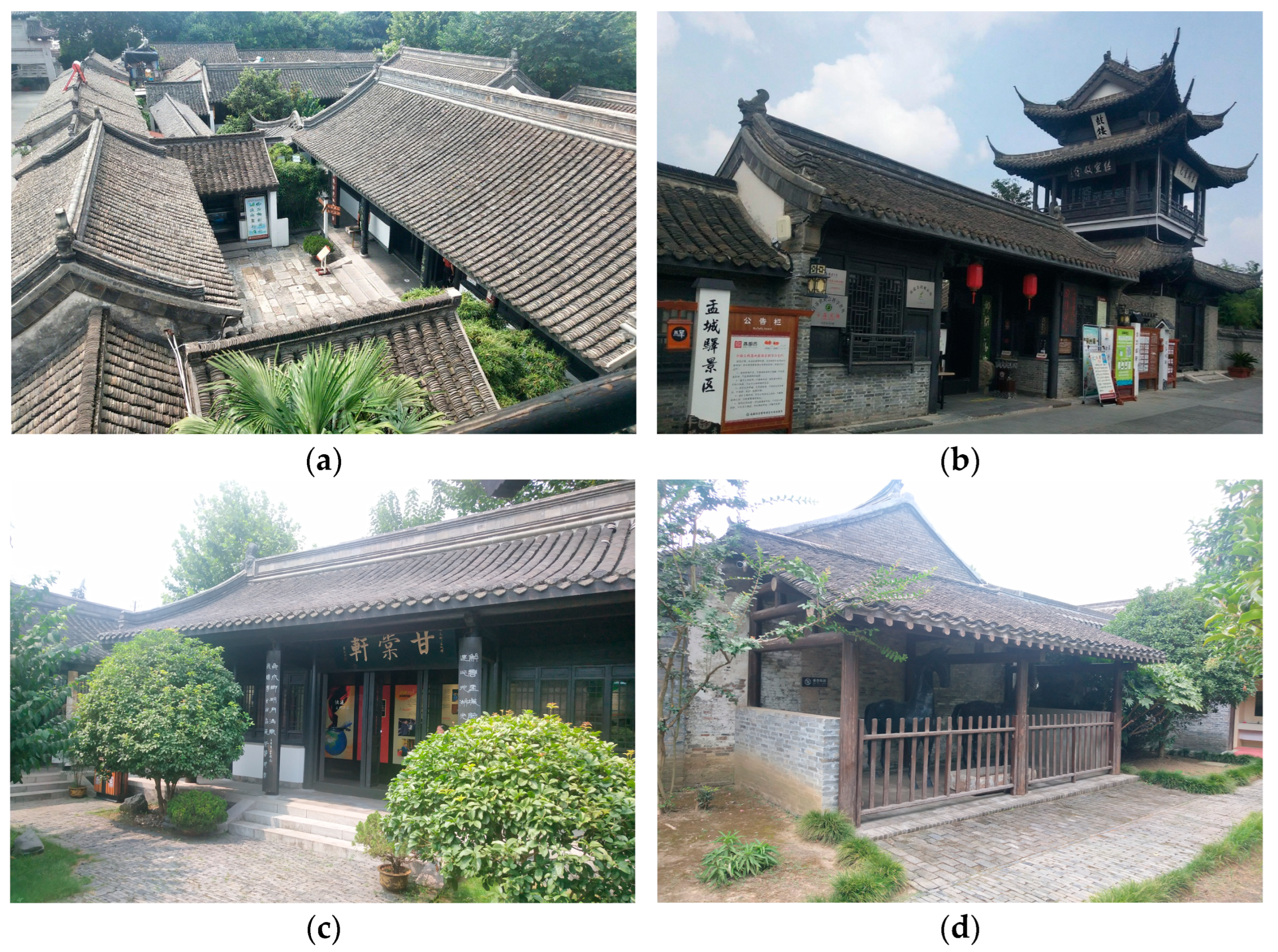
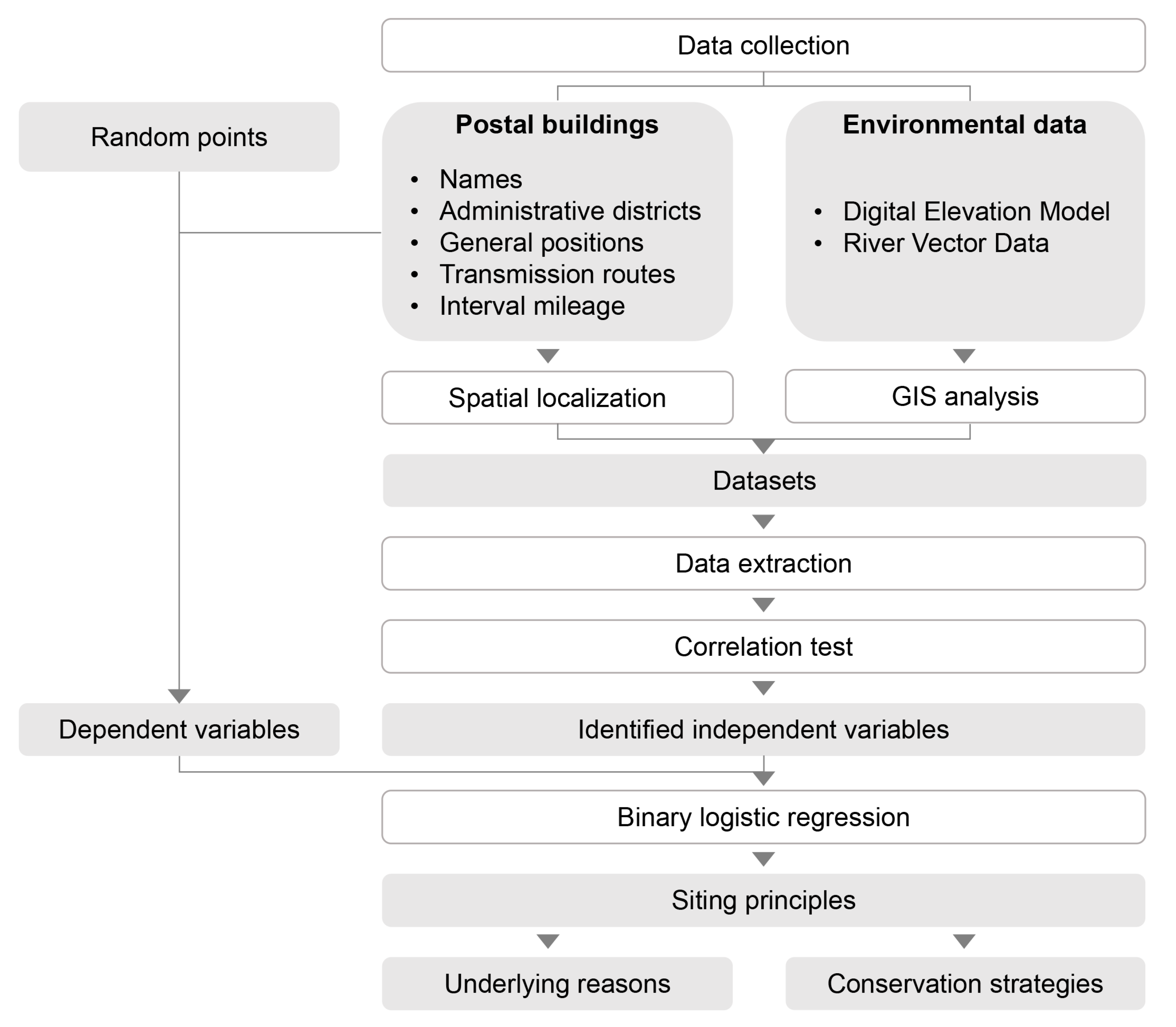
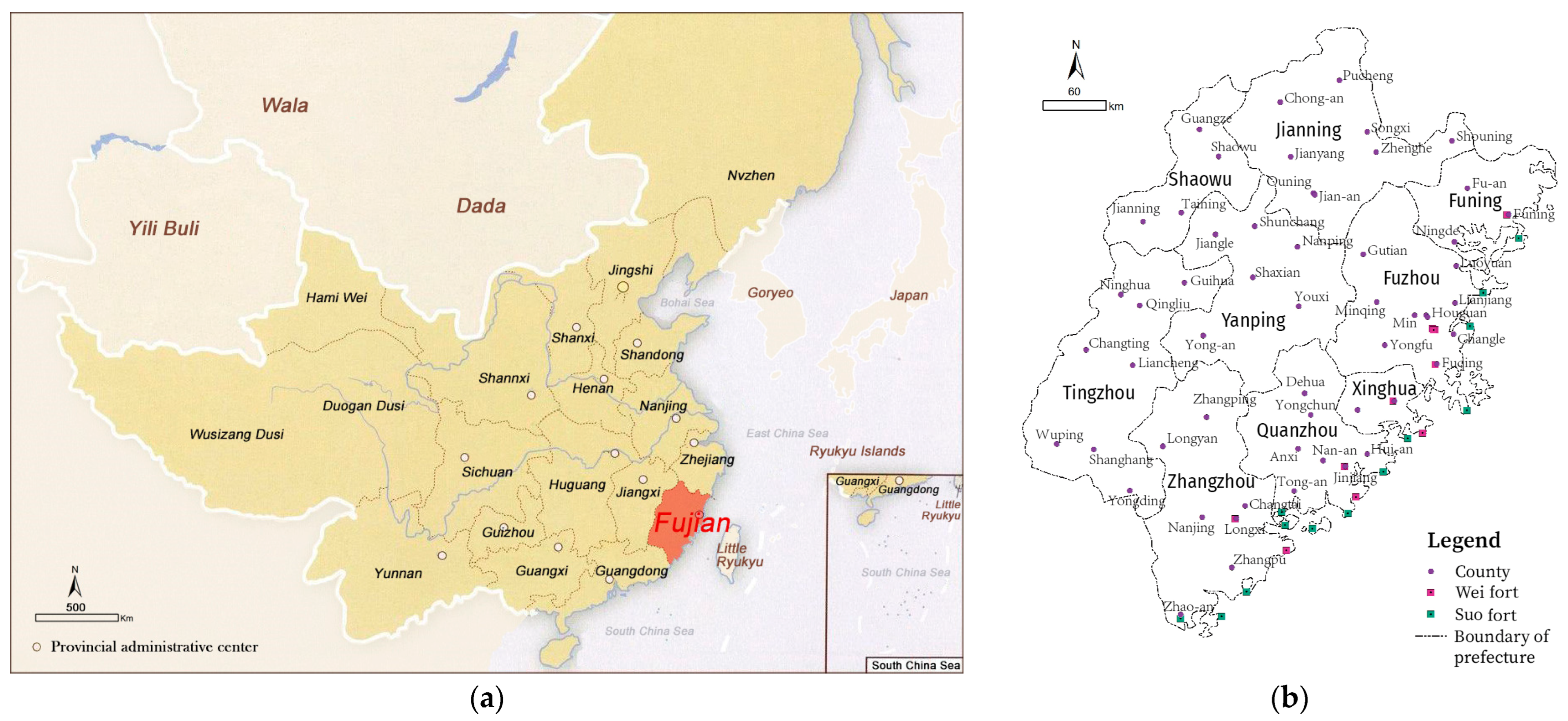
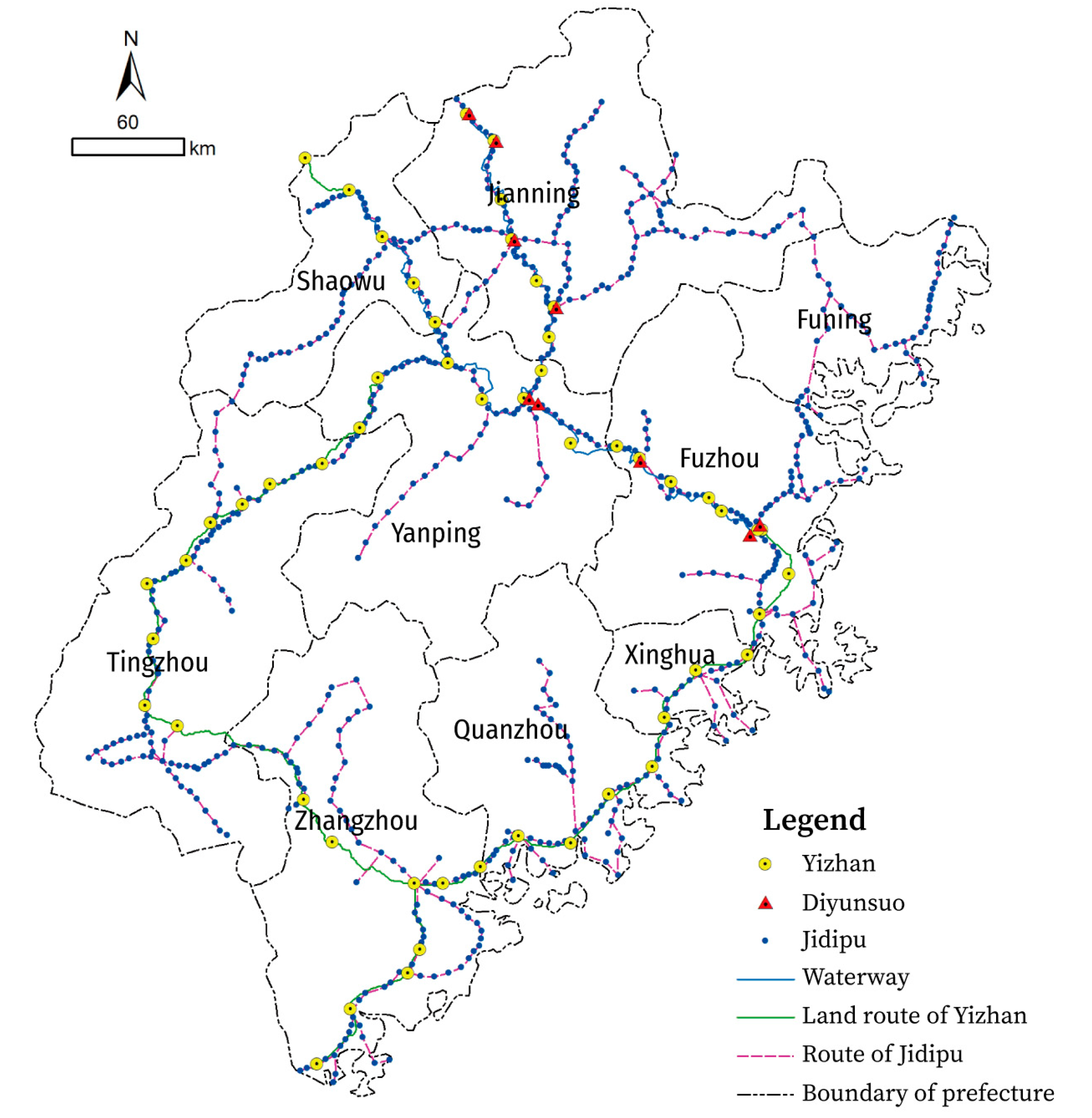
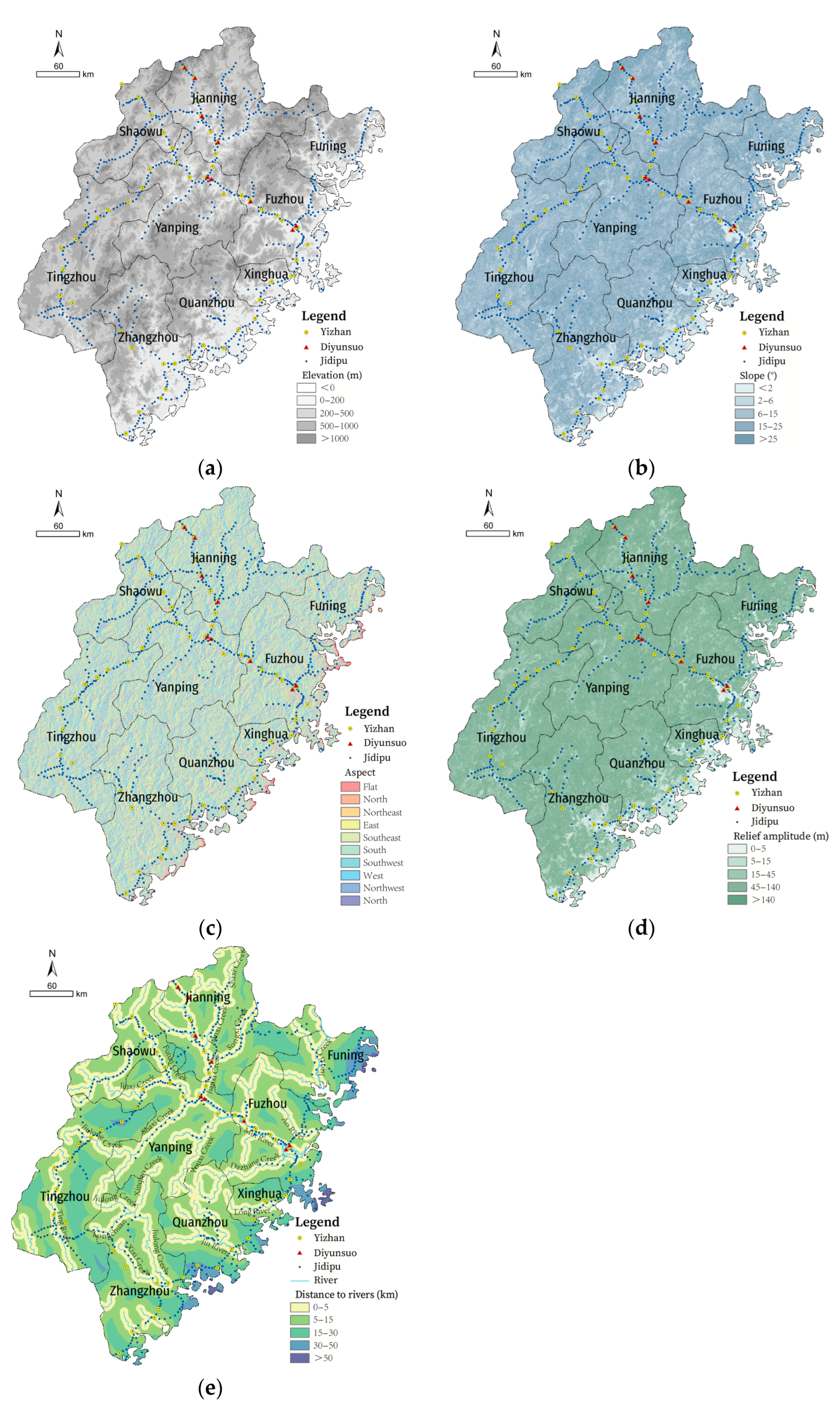


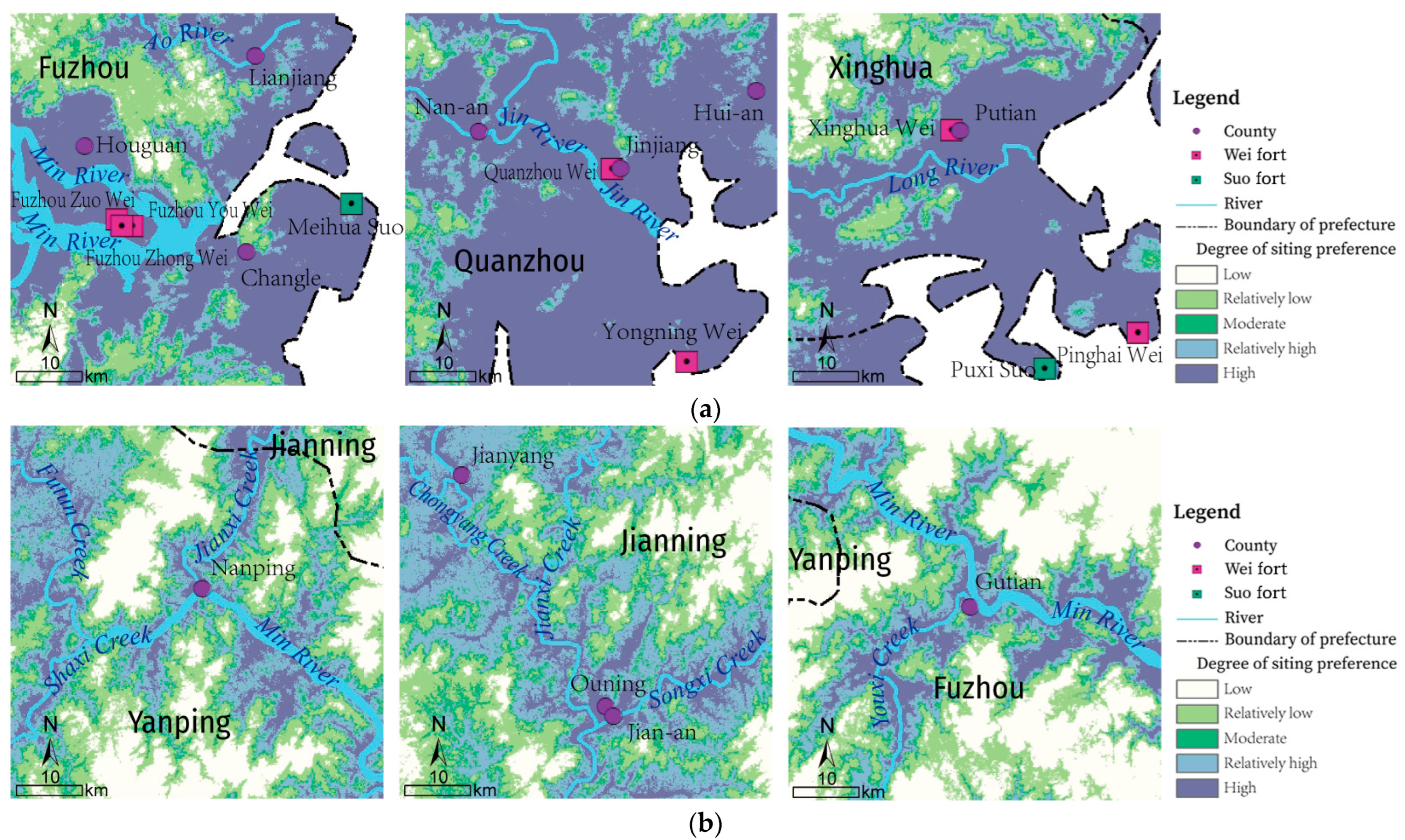
| Environmental Factor | Sub-Region | Area (km2) | Ai | Ei | Wi |
|---|---|---|---|---|---|
| Elevation (m) | <0 | 863.80 | 0 | 5 | 0 |
| 0–200 | 23,793.62 | 400 | 147 | 2.72 | |
| 200–500 | 44,560.31 | 298 | 275 | 1.08 | |
| 500–1000 | 46,664.24 | 60 | 288 | 0.21 | |
| >1000 | 6857.70 | 0 | 42 | 0 | |
| Slope (°) | <2 | 8337.97 | 134 | 51 | 2.60 |
| 2–6 | 16,400.16 | 182 | 101 | 1.80 | |
| 6–15 | 42,021.79 | 248 | 260 | 0.96 | |
| 15–25 | 38,323.05 | 145 | 237 | 0.61 | |
| >25 | 17,656.70 | 49 | 109 | 0.45 | |
| Aspect | Flat | 1459.84 | 10 | 9 | 1.11 |
| North | 14,266.79 | 79 | 88 | 0.90 | |
| Northeast | 14,570.94 | 76 | 90 | 0.84 | |
| East | 15,602.82 | 74 | 96 | 0.77 | |
| Southeast | 16,687.37 | 106 | 103 | 1.03 | |
| South | 15,187.42 | 103 | 94 | 1.10 | |
| Southwest | 14,685.20 | 108 | 91 | 1.19 | |
| West | 14,910.62 | 102 | 92 | 1.11 | |
| Northwest | 15,368.67 | 100 | 95 | 1.05 | |
| Relief amplitude (m) | 0–5 | 4789.68 | 47 | 29 | 1.59 |
| 5–15 | 8430.11 | 161 | 52 | 3.10 | |
| 15–45 | 34,186.23 | 263 | 210 | 1.25 | |
| 45–140 | 72,456.59 | 281 | 446 | 0.63 | |
| >140 | 3267.88 | 6 | 20 | 0.30 | |
| Distance to rivers (km) | 0–5 | 40,239.15 | 429 | 245 | 1.75 |
| 5–15 | 55,307.78 | 162 | 337 | 0.48 | |
| 15–30 | 24,887.42 | 122 | 152 | 0.80 | |
| 30–50 | 3392.40 | 43 | 21 | 2.08 | |
| >50 | 466.50 | 2 | 3 | 0.69 |
| Variable | β 1 | S.E. 2 | Wald 3 | Df 4 | Sig. 5 | Exp(β) 6 |
|---|---|---|---|---|---|---|
| Elevation (X1) | −0.004444 | 0.000317 | 197.105177 | 1 | 0.000000 | 0.995566 |
| Slope (X2) | 0.050505 | 0.020066 | 6.334937 | 1 | 0.011838 | 1.051802 |
| Relief amplitude (X3) | −0.017617 | 0.005207 | 11.447286 | 1 | 0.000716 | 0.982537 |
| Distance to rivers (X4) | −0.000016 | 0.000007 | 5.670057 | 1 | 0.017257 | 0.999984 |
| Constant | 1.987054 | 0.140941 | 198.766831 | 1 | 0.000000 | 7.294017 |
| Degree | Number | Proportion |
|---|---|---|
| Low preference | 35 | 4.64% |
| Relatively low preference | 118 | 15.63% |
| Moderate preference | 75 | 9.93% |
| Relatively high preference | 203 | 26.89% |
| High preference | 324 | 42.91% |
Disclaimer/Publisher’s Note: The statements, opinions and data contained in all publications are solely those of the individual author(s) and contributor(s) and not of MDPI and/or the editor(s). MDPI and/or the editor(s) disclaim responsibility for any injury to people or property resulting from any ideas, methods, instructions or products referred to in the content. |
© 2025 by the authors. Licensee MDPI, Basel, Switzerland. This article is an open access article distributed under the terms and conditions of the Creative Commons Attribution (CC BY) license (https://creativecommons.org/licenses/by/4.0/).
Share and Cite
Wu, B.; Tan, L. Siting Principles of the Ancient Postal Buildings Under Environmental Constraints. Buildings 2025, 15, 3047. https://doi.org/10.3390/buildings15173047
Wu B, Tan L. Siting Principles of the Ancient Postal Buildings Under Environmental Constraints. Buildings. 2025; 15(17):3047. https://doi.org/10.3390/buildings15173047
Chicago/Turabian StyleWu, Bei, and Lifeng Tan. 2025. "Siting Principles of the Ancient Postal Buildings Under Environmental Constraints" Buildings 15, no. 17: 3047. https://doi.org/10.3390/buildings15173047
APA StyleWu, B., & Tan, L. (2025). Siting Principles of the Ancient Postal Buildings Under Environmental Constraints. Buildings, 15(17), 3047. https://doi.org/10.3390/buildings15173047






